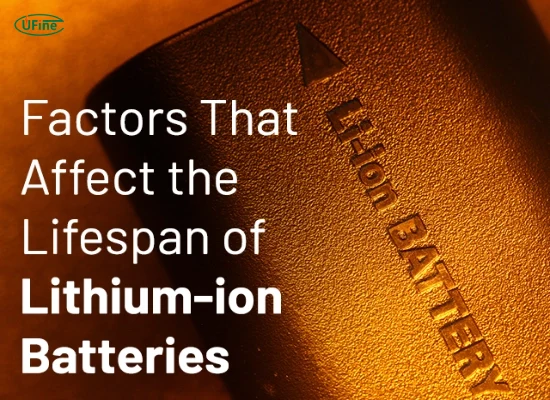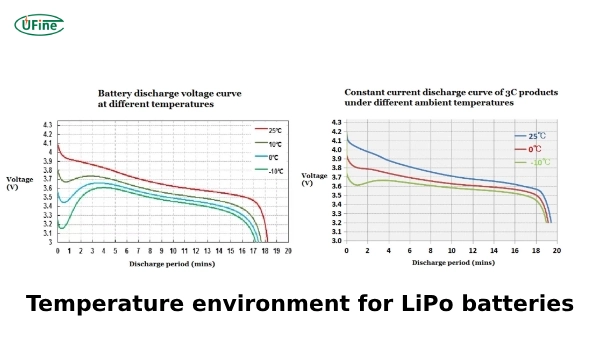Lithium batteries are rechargeable with lithium compounds as active materials for cathode and anode. Lithium batteries are widely used in mobile devices, electric vehicles, and wearable devices because of their high energy density, lightweight, and long life. To make lithium battery products better used, we need to understand the reasons affecting the life of lithium batteries and how to care for lipo batteries. The following section will discuss this content with you.
Part 1. Reasons affecting the life of lithium battery
Charge Cycles: The number of charge-discharge cycles a lithium battery undergoes affects its longevity, with each cycle contributing to gradual capacity loss.
Operating Conditions: Extreme high and low temperatures can degrade a lithium battery’s performance and shorten its lifespan.
Overcharging/Deep Discharging: Subjecting lithium batteries to overcharging or allowing them to discharge completely can stress the cells and reduce their lifespan.
Quality of Charging Equipment: Using improper or low-quality chargers can impact battery health, leading to overcharging or uneven charging, thereby affecting longevity.
Storage Conditions: Storing lithium batteries at high states of charge or in excessively humid environments can contribute to capacity loss over time.
Physical Damage: Accidental damage, such as punctures or impacts, can compromise the integrity of lithium batteries, impacting their lifespan and safety.
Part 2. LiPo batteries care methods
Taking care of lithium batteries involves two primary aspects: battery charging and daily storage practices, both crucial for ensuring their longevity and optimal performance.
LiPo batteries charging
Ensuring a stable and secure charging process for lithium polymer batteries involves a few crucial steps:
Selecting the Right Charger: Opting for a charger that aligns with the battery’s power specifications significantly enhances stability during charging. Matching power requirements reduces the risk of accidents and contributes to a smoother charging experience, improving the battery’s longevity.
Avoiding Overcharging: Unlike some battery types, lithium-ion battery packs lack a memory effect. Therefore, there’s no need to overcharge them for activation or to remember maximum capacity. While many lithium-ion battery chargers come with charge protection mechanisms, cultivating good charging practices further extends the battery’s lifespan.
LiPo batteries discharging
Safeguarding lithium polymer batteries during discharging involves critical considerations beyond avoiding overcharging. Over-discharging poses another significant risk. It disrupts the stability of the battery’s structure by forcing an excessive migration of lithium ions from the anode. This disturbance compromises the structural integrity of the anode, leading to irreversible damage.
Maintaining a balance in lithium-ion migration is crucial to preserve the stability and functionality of the battery. Over-discharge disturbs this delicate balance, accelerating wear and tear on the battery’s components and ultimately impairing its overall performance. Avoiding such instances of over-discharging is pivotal to ensuring the longevity and sustained efficiency of lithium polymer batteries.
Part 3. Temperature environment for LiPo batteries
The charging temperature environment
The optimal charging environment for lithium-ion batteries is 5 to 45℃. Although charging can still be done generally at 0 to 5℃, the charging current should be reduced relative to (5 to 45℃environment) to maximize battery life.
Charging at high temperatures or above 45℃will degrade battery performance and even contaminate the electrolyte within the battery. Low temperatures or below 0℃will result in new internal resistance, leading to longer charging times. Additionally, when setting at temperatures below 0℃, the battery will be in a sub-freezing condition, which can cause irreversible damage to the battery.
The discharging temperature environment
Lithium-ion battery discharge ambient temperature is generally -20℃ ~ 60℃, but usually lower than 0℃lithium-ion battery performance will decline. The discharge capacity will be reduced accordingly, so the daily lithium-ion battery performance of the total operating temperature is 0 ~ 40℃. Some customized lithium-ion battery temperatures are different; some can even be in the hundreds of degrees Celsius in the regular operation of the environment.
Part 4. LiPo battery storage and care
- Lithium-ion batteries can be stored in a clean, dry, and ventilated environment with a temperature of -5 to 35℃ and a relative humidity of not more than 75%.
- It should be prevented from contact with corrosive substances, kept away from ignition and heat sources, not placed in direct sunlight, and the battery should not be disassembled at will.
- If the battery is stored for an extended period, regular battery calibration is necessary to ensure that the state of charge and power display are accurate. This can be accomplished by completely discharging and recharging the battery to help the battery management system more accurately estimate the remaining charge. This article recommends that batteries in long-term storage be charged every six months.
- Do not mix the battery with metal objects so that metal objects do not touch the positive and negative terminals of the battery and cause a short circuit, damaging the battery or even causing danger.
- Do not knock, pinch, step on, modify, or sunlight the lithium-ion battery, and do not place the battery in microwave or high-pressure environments.
Part 5. Conclusion
Lithium batteries require attention to temperature control, avoiding overcharging and discharging, selecting appropriate chargers and charging modes, and regular charging and discharging for battery calibration. Following these methods and precautions can extend the life of lithium batteries and improve their performance and safety. It is also essential to refer to the manufacturer’s recommendations and guidelines for more accurate charging methods and maintenance according to different types of equipment and lithium batteries.
Part 6.FAQs
-
Is it better to leave LiPo batteries fully charged?
It’s better to store LiPo batteries at around 50% to maintain longevity; keeping them fully charged for extended periods can reduce their lifespan. -
What is the life expectancy of a LiPo battery?
A well-maintained LiPo battery can last around 300-500 charge cycles. Still, its lifespan can vary based on usage, storage, and charging habits. -
Why do LiPo batteries get puffy?
LiPo batteries swell or become puffy due to overcharging, excessive discharging, physical damage, or manufacturing defects, leading to the expansion of internal components. -
What do LiPo safe bags do?
LiPo safe bags are fire-resistant containers that safely store and charge LiPo batteries, containing any potential fire or explosion within the bag to minimize damage and hazards.
Related Tags:
More Articles

LiPo Battery Discharge Rate Guide & Calculation Tips
Understand LiPo battery discharge rates, C-ratings, and how to calculate max current. Essential guide for RC, drones, and electronics users.
High‑Capacity 3S LiPo Batteries: 5000 mAh vs. 10000 mAh
Compare 3S LiPo 5000mAh vs 10000mAh batteries by weight, power, and use. Find the best fit for your drone, RC car, or boat setup.
Top 5 Applications for Small 3S LiPo Batteries
Small 3S LiPo batteries power drones, RC gear, wearables, and robotics with high energy and low weight. Making them ideal for compact electronics projects.
Building and Charging Your Own 3S LiPo Pack: A Step‑by‑Step Guide
Learn how to build, balance, and charge a 3S LiPo battery pack safely at home with this complete DIY guide for hobbyists and beginners.
How to Choose the Right LiPo Battery Plug Type?
Discover the best LiPo battery plug types, how to choose them, and expert tips for safe usage, soldering, and maintenance.





